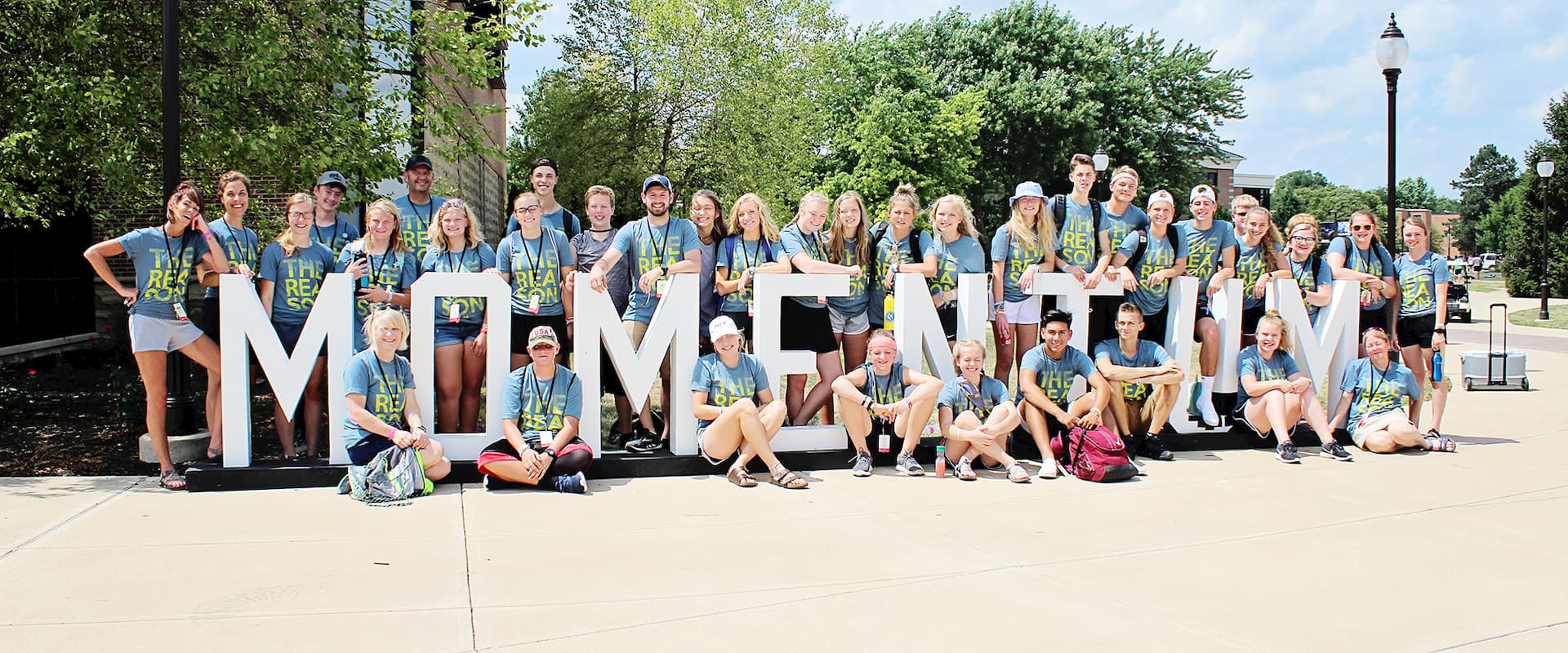Eric Miller, director of ministry operations for CE National, talks with Erin O’Hara, Angie Dallavalle, and Fletcher Abbott about how to connect your children’s ministry with your youth ministry.
Erin, Angie, and Fletcher are on staff at Grace Community Church in Frederick, Maryland. Erin is children’s director, Angie is middle school director, and Fletcher is high school director for the church.
To find out more about Digital Labs, visit buildmomentum.org/blog.
Eric Miller, director of ministry operations for CE National, talks with Erin O’Hara, Angie Dallavalle, and Fletcher Abbott about how to connect your children’s ministry with your youth ministry.
Erin, Angie, and Fletcher are on staff at Grace Community Church in Frederick, Maryland. Erin is children’s director, Angie is middle school director, and Fletcher is high school director for the church.
What is the scope of your ministry and how are you connected?
Erin said their children ministry serves about 100 children from nursery through 5th grade. They have a Wednesday night girl’s ministry that runs for 6-8 week blocks that focuses on spiritual growth areas in the Scripture.
They run a summer growth club, much like Vacation Bible School, on Sunday mornings to engage families over the summer. She also oversees a kids program for 4th and 5th graders.
Angie’s middle school program serves 40-50 middle school students. They run a Wednesday night discipleship program. Sunday mornings they run a Bible study. She also manages a middle school leadership team. Middle school and high school run in tandem. They have one unified ministry program with touch-points where they engage with one another.
Fletcher reiterated that the high school ministry runs in tandem with the middle school ministry. There is even the same branding which is intentional. Some aspects are separate to make sure they fit the needs of students. For example, adult volunteers are separate between middle and high school.
How did the leadership programs develop?
Erin said that two summers ago they noticed leadership in children and wanted to promote it. Angie had already started a middle school leadership team. They decided that it would be good to give 3rd, 4th, and 5th graders opportunities to lead and serve. This really helped the kids engage their faith and put into practice what they learned. The leadership started with Vacation Bible School by having kids lead worship on the stage, participate in photography, small group leader assistant, cleanup, and setup. Out of that they saw a great desire to develop a leadership curriculum and plug them into serving roles within the church like greeting, security, and checking in kids. As kids engaged in the big church, they developed relationships within the church to continue to walk in the church community as they grew older. This is a passion in which they want to see the kids engaged.
Angie said the Kids Lead program is the newest program within the middle school that she’s developed. She enjoys seeing the kids grow as leaders as they go into middle school. The staff tries to identify what their spiritual gifts are and put them in the right roles, But there’s a lot of trial and error. The kids get to engage in the planning, to have ownership, and have a voice throughout the ministry. The children’s ministry already gives them the opportunity to serve. Middle school students are paired with an adult which helps them come to know their place in the church as a whole. This makes them part of the church in a very tangible way.
Fletcher, How do you pick up the middle school students and continue to develop them as leaders?
Fletcher said that one unique addition is that they are helping their student leaders grow in their self-awareness. The students don’t just feel like they have a title, but that they have influence on others. For example, this helps students see how they help to set the tone in a discussion which shows them how they can help others and pour back into other students.
What did things look like before you partnered together?
Erin has been on staff the longest and worked with Eric when he was the youth pastor at the church. She recognizes that ministry staff often have to meet the immediate needs. Sometimes they are just surviving week-to-week. It takes intentionality to figure out what students really need and that takes time. Erin says that early on there wasn’t a lot of time to go deeper with Eric as the youth pastor. At the time the offices were even silo-ed, hours were different, and they weren’t around each other to interact. The church has renovated and now offices are all together and even amidst COVID they’re being intentional about meeting through video chat.
It’s helped because all three staff members have kids in each other’s ministries. This has created a good culture to understand what the needs of parents are in each other’s ministries.
Angie said there was a strategic change in staffing which helped. Eric was over middle and high school while Erin was serving as solo children’s director when the church hired a co-director to help Erin. This helped, but there was still a gap in student ministry. That’s when the church hired Angie as middle school director. This gave someone time to specifically focus on middle school ministry and helped to be more intentional moving students into the middle school ministry.
Fletcher: Where do you see the importance of working together?
Fletchers says, “It is one thing to say I have, at best, four years with a student to invest in them from beginning to end. It’s another thing to say that I get to pick up from where this student has been invested in for 14 years and I get to carry through for the next four years. It means you get to start hitting the ground running instead of square one.” Fletcher goes on to say that it’s not just that these students have this great foundation, but they have a more realistic understanding of what they’re getting themselves into. Before they weren’t sure what was expected from Fletcher and others. Now they’re coming into the senior high ministry with a level of anticipation that they’re ready to get started.
Angie said there’s an investment prior to getting there. The three of them talk regularly about how they can work together. They also pray for students in each other’s ministry. It makes an incredible difference to already be connected with students coming in.
Erin, why do you see the need for better connecting of the ministries?
Erin says it’s easy for kids to fall through the cracks. It’s important to make kids feel welcome going into the youth group as 5th graders. They’re very intentional about running activities to welcome kids into middle school. This gets kids excited about the next level. It’s also very important to have the kids connected so, as middle schoolers, they come back into the children’s ministry. It’s great to have a teenage girl who wants to be in a kid’s class or another student who wants to lead worship. Erin knows that she’ll still have touchpoints with the kids who leave her ministry.
What are some concepts for students to have had as they enter into youth ministry?
Fletcher said that this is one of the things they’re learning how to do well. They’re further along than a lot of others since they know what they’d like to have happen, but they’re working on what it looks like for the kids to have full ownership. The church’s DNA is making disciples. For these three staff members it’s been figuring out what that looks like from a youth/children’s ministry perspective. Although they have yet to do it, the three here recommend putting a plan down on paper. God is doing some really good things through their church, but they don’t have it all together.
The three ministries talk about “head, heart, and hands”. The children’s ministry has a lot of “head” which means they teach the kids the Bible by repeating stories and where things are at in the Bible. It’s repetitive to get the knowledge into the students. There is some “heart” and some “hands” but a lot more is pointed toward head knowledge to get kids the basic foundation.
In middle school they shift to heart-based focus because students at that age can think abstractly and look at the world around them. They want the kids to connect with Christ on a heart level. They want them to believe, not because their parents have taken them there, but because they believe it themselves.
In high school it’s more about the hands. It’s what the students are doing to actually live it out. They also focus on how they help someone else figure out what they believe. It’s preparing them to go into the world after they graduate.
What would you say has been the hardest thing to overcome in connecting the ministries together?
The three of them agreed that the time needed is the hardest thing. Erin said that having the time to pray and strategically plan is important.
What advice or encouragement would you give to other leaders
Fletcher said that it’s important to take advantage of the opportunities. In some ways COVID has given them the time to start talking more intentionally. COVID has given them the opportunity to be more collaborative. Fletcher stressed the importance of being champion for the other ministries. The easiest way to not be a silo-ed ministry is to be a champion of the other ministries.
Angie said they sometimes serve in other ministries. For example, Angie does a study with the pre-teens before they go into middle school. Erin adds that knowing the strengths and weaknesses of the other leaders helps. Erin meets with the others to get their wisdom.
Fletcher brags about what’s going on in the other ministries as much as what goes on in his ministry. Angie says they celebrate what happens in the other ministries.
For churches that don’t have a paid staff member for each ministry how can they implement this?
Fletcher said first off to pray. Whether you are a volunteer or working with volunteers, you can’t do it all on your own.
Angie said to look to great resources like CE national. All three leaders are involved in different groups outside of their own church for prayer, troubleshooting, and to find encouragement. Focus on what you can do and not on what you can’t do. Look at the kids in your ministry, what God’s doing, and lean into that. Then take small steps toward the vision God has placed in your heart.
Erin said to look for the people you can invest in. It’s easy for leaders to do it all, but give opportunities for kids and adults to lead. Remember that comparison is the thief of joy. While you connect with other ministries, don’t think the other ministries have it all together. God has equipped you, do what He’s called you to do.
Related Articles
11 Keys to Keep Your Church’s Volunteer Children’s Staff Happy







0 Comments
Trackbacks/Pingbacks